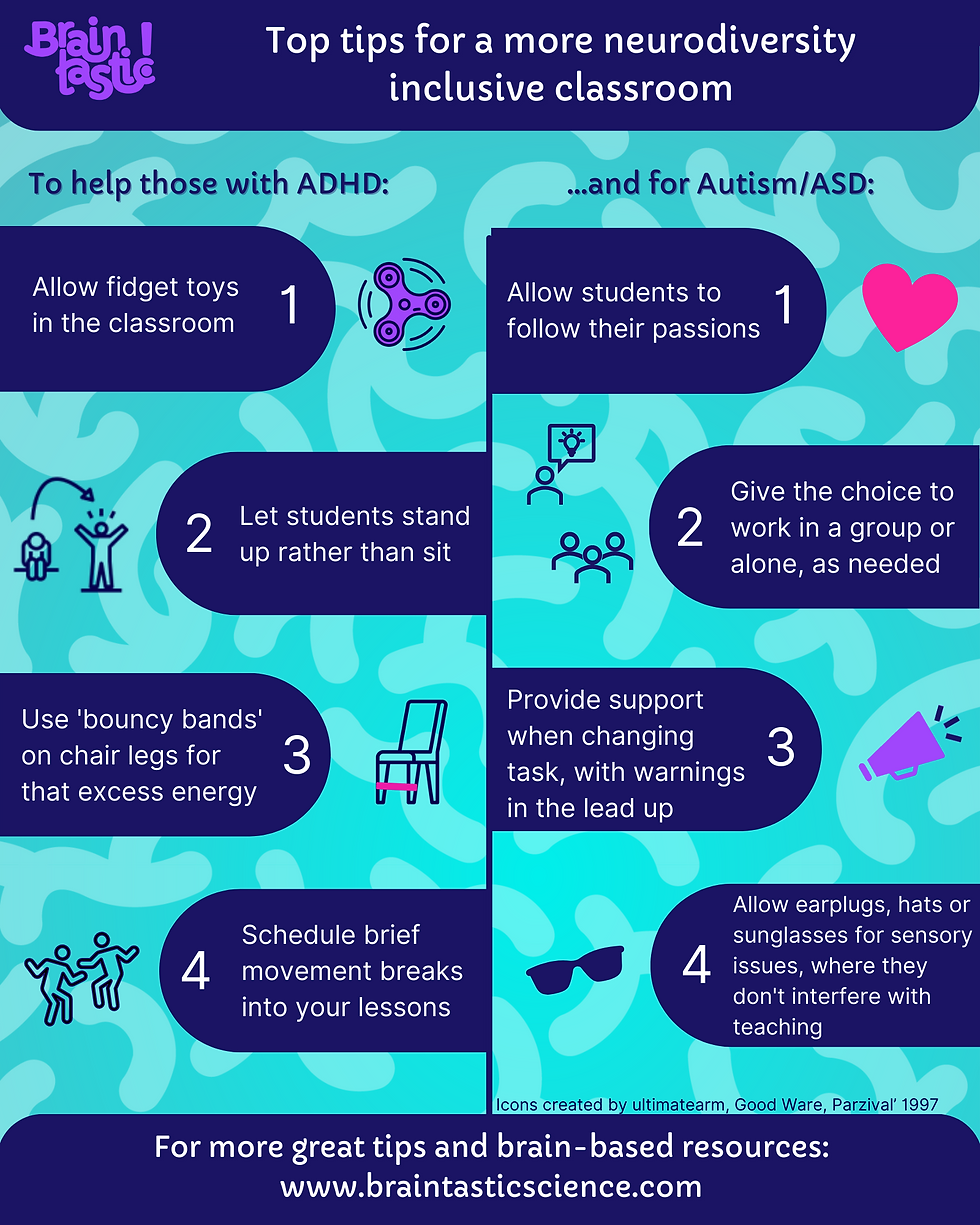How to Create an Inclusive Classroom for Neurodiversity
- ginnysmith1
- Oct 24, 2022
- 3 min read
Updated: May 4, 2025
Neurodiversity is the idea that brains come in lots of different types, and that this isn’t
a problem. It’s not even neutral. It’s actually beneficial to our society.
Just like the richest environments are those with lots of different plants and animals (high levels of biodiversity), our aspirations for the future of society shouldn’t be to ‘fix’ people whose brains work a little differently, but to embrace and celebrate them.
There are a huge range of diagnoses that might come under the umbrella term ‘neurodivergent’. The most commonly discussed are Autism Spectrum Disorder (ASD) and Attention Deficit Hyperactivity Disorder (ADHD), but others include dyslexia, dyspraxia and dyscalculia. Basically, it refers to people whose brains process information differently. Sometimes, the definition is expanded to include people with mental health conditions.
This builds on the social model for disability. This states that rather than a disability being something intrinsic to a person, and therefore their problem, it is the environment that disables them. So someone may be unable to walk, but it is the lack of ramps into a building that disables them, not their non-functional legs. Someone might be blind, but it is a failure of society to provide them with a braille option at a museum that causes them to be unable to access that museum. While I like the concept of this model of disability, I don’t think it works for all disabled people. I, for instance, have a chronic illness, and no amount of societal change or accommodation will mean I’m not in pain, or take away my fatigue. But I do think it’s an interesting concept, to flip disability on its head (so to speak!) and make accessibility everyone’s issue, rather than just the disabled person’s.
So how does this apply to neurodiversity? Well, it suggests we should make changes to the environment to make neurodivergent people feel as welcome as possible, and to help them get the best out of their brains, even if it might seem unusual to neurotypicals. To help you consider how to apply that in your school, here are some top tips for an inclusive classroom:

While these accommodations are designed for students diagnosed with ADHD or ASD, teachers often find their other students benefit from an inclusive classroom too.
As with neurotypical individuals, neurodivergent students vary widely in the difficulties they have, and the workarounds that help them manage their condition. If you know you have a neurodiverse classroom, the best way to start is by talking to each individual about what would help, or to their parents or caregivers, if they are very young. For students without a diagnosis, the best approach is to be kind. Remember we all have different needs, and find safe and non-disruptive ways to accommodate different types of human. Not only will this help the students who need these accommodations, but it also models non-judgemental, supportive behaviour to other students, hopefully helping to build a world where those with brain differences suffer less stigmatisation and discrimination and are instead celebrated for their strengths and differences.
It's also important not to underestimate the importance of seemingly small things. One of our fab Braintastic! presenters, Mike, was only diagnosed with dyslexia as an adult, but spent his school years feeling like he wasn't 'traditionally academic'. As he says:
"The only subjects I did well in were Drama and P.E., and it was these which gave me confidence to take education further. I absolutely wouldn’t have completed a PhD in Cognitive Science had I not done Drama or P.E. at school! So don't underestimate the power of non-STEM subjects!"
One of our missions at Braintastic! Science is to smash the stereotype that STEM subjects are difficult, stuffy and only for academic high-achievers. There is so much talent out there, and we think that the more diverse the scientists of the future, the better the world we will be able to create. And that means giving everyone the chance to imagine themselves having a career in science.
If you'd like to talk about how we can encourage your students to explore careers in STEM, please do get in touch.











